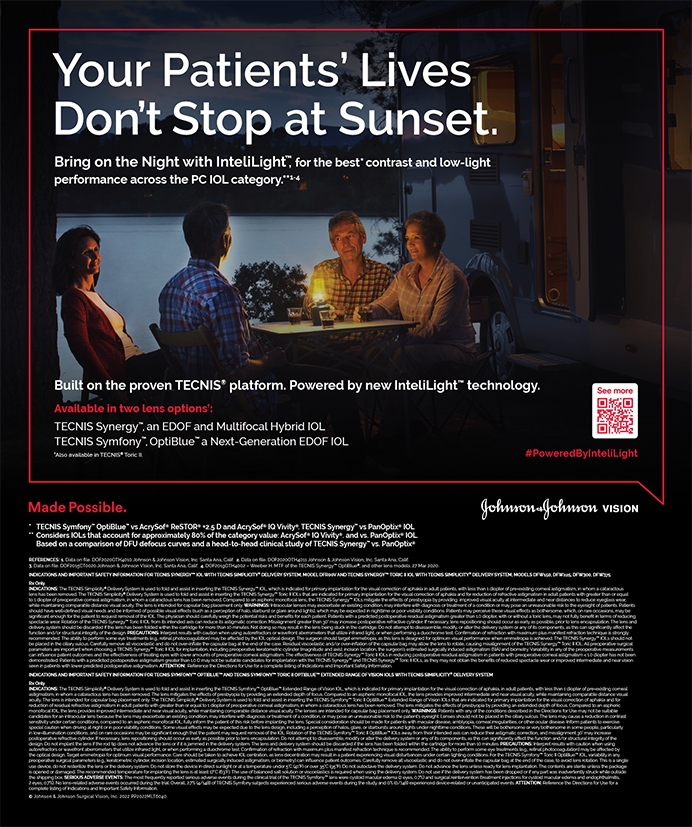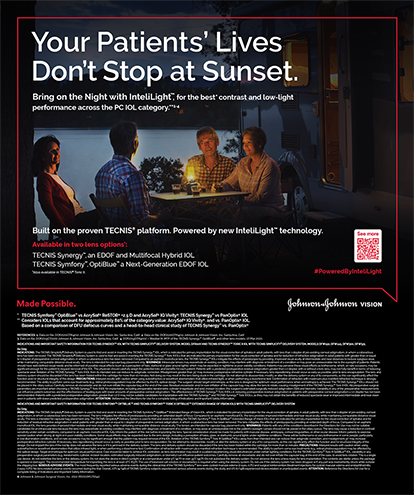I have been using intraoperative aberrometry for 6 years. Improvements to the technology have made it an increasingly important tool for selecting the appropriate IOL power and determining the correct axis and magnitude of astigmatism. I use the ORA System with VerifEye (WaveTec Vision) for premium IOL cases, eyes with astigmatism, unusually long or short eyes, and eyes that previously underwent refractive surgery, which are the most challenging cases of all. I have come to trust the device’s IOL power calculation over my own preoperative calculations, but the case described herein initially challenged my confidence in the technology.
AN INTRAOPERATIVE SURPRISE
A 66-year-old woman who underwent a successful eight-incision radial keratotomy (RK) in 1984 wanted to maintain spectacle independence for distance vision after cataract surgery. For eyes that have undergone refractive surgery, I rely on the flattest corneal curvature on topography. Figure 1 shows this patient’s topography.
After RK, I aim for a refraction of -0.50 to -1.00 D to account for the hyperopic drift that occurs many years after refractive surgery. In this particular case, I calculated the IOL power with several different formulas, including the Haigis-L, Holladay 2, and Shammas post-LASIK as well as the American Society of Cataract and Refractive Surgery’s postrefractive surgery IOL calculator. Because power calculation after RK is notoriously unreliable, I sought the opinions of three top US IOL specialists at a regional meeting, all of whom agreed with my preoperative choice of a 17.50 or 18.00 D IOL for the patient’s right eye. I planned to implant an 18.00 D Tecnis ZCB00 IOL (Abbott Medical Optics).
After removing the cataract, I checked the aphakic refraction and was surprised that the intraoperative aberrometer recommended a 20.50 D lens. Although it is not uncommon for me to change my IOL selection in the OR by 0.50 to 1.00 D based on intraoperative aberrometry, a difference of 2.50 D from my preoperative calculation is unusual. I checked that nothing was preventing an accurate reading. The speculum had been loosened, the IOP was over 25 mm Hg, and the patient was fixating correctly. I repeated the measurement four more times. Although I usually perform one aphakic capture, I will repeat the measurement once or more when the result is unexpected. In this case, all five readings identified the best IOL power to be 20.50 D (twice) or 21.00 D (three times). Figures 2 through 4 show three of the ORA’s aphakic measurements. I decided to trust the reading, although I opted to implant the lower of the two powers.
RESULTS
Two weeks postoperatively, the patient was slightly hyperopic, as I would expect in a post-RK cataract case while the wound is edematous. Three months postoperatively, the manifest refraction was +0.25 D. If I had put more trust in intraoperative aberrometry and implanted the 21.00 D lens, the result would have been plano. A +0.20 D outcome is certainly better than the +2.00 D result that would have occurred with my original IOL choice.
IMPROVED OUTCOMES
I see four to six patients with a history of refractive surgery every day for cataract consultations. They are typically excellent candidates for premium services such as multifocal IOLs and laser cataract surgery. These patients are accustomed to good uncorrected vision. Additionally, they were willing to have (and pay out of pocket for) refractive surgery in the past. Those who underwent RK are clearly early adopters with a high tolerance for risk.
This case is an extreme example, but it clearly demonstrates that the aphakic intraoperative aberrometry measurement of the eye’s refractive power is more accurate than relying on preoperative S/b IOL power calculations alone. The reason is that the device provides refractive information based on the power at the patient’s line of sight, which is not always the same as the center of the cornea. There can be significant shifts on topography in corneal power just from a 0.1- or 0.2-mm deviation from the line of sight. Intraoperative aberrometry also accounts for surgically induced astigmatism from the incision and astigmatism from the posterior cornea.
Initially, I found it hard to set aside my calculated IOL power in favor of the one picked by this device, but over time and with experience, I have come to rely on intraoperative aberrometry as a companion in the OR. It enhances accuracy and increases the chance that I will provide patients with the refractive outcomes they want.
With ORA, my enhancement rate in complicated cases involving previous LASIK and RK has decreased from more than 40% to less than 10%.
Certainly, the informed consent process is vital to success in patients with a history of RK. I counsel them that the variability of the refractive result after RK is greater than after LASIK, which in turn is greater than in eyes that have never had refractive surgery. I explain that there is a greater possibility they will need an enhancement such as an IOL exchange, surface ablation, or limbal relaxing incisions.
In routine cases, the intraoperative aberrometry reading leads me to change my lens selection about half the time, representing an incremental improvement that gets me closer to LASIK-like results in cataract surgery. In unusual cases like this one, the ORA refraction and IOL selection are far superior to other available methods. The technology has also significantly improved my outcomes for long and short eyes; the percentage of short eyes within 0.75 D of the intended correction has gone from 84% to 94%.
CONCLUSION
Trusting intraoperative aberrometry—even when the measurement tells me my original choice is off by more than 2.50 D—is probably the most important thing I have done to improve the accuracy of my IOL selection and my patients’ satisfaction.
Section Editor Kathryn M. Hatch, MD, practices corneal, cataract, and refractive surgery at Talamo Hatch Laser Eye Consultants in Waltham, Massachusetts.
Section Editor Colman R. Kraff, MD, is the director of refractive surgery for the Kraff Eye Institute in Chicago. Dr. Kraff may be reached at ckraff@kraffeye.com.
Eric D. Donnenfeld, MD, is a professor of ophthalmology at NYU and a trustee of Dartmouth Medical School in Hanover, New Hampshire. He is a consultant to Abbott Medical Optics and WaveTec Vision. Dr. Donnenfeld may be reached at (516) 766-2519; ericdonnenfeld@gmail.com.


